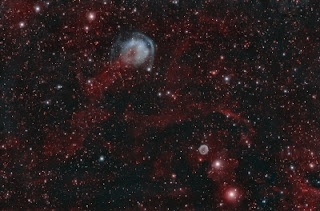This field of view includes two extremely faint planetary nebulae in the constellation Cassiopeia.
In the upper part of the image, we find Heckathorn-Fesen-Gull 1 (HFG1, also catalogued as PK 136+05).
HFG1 was discovered by J. N. Heckathorn, R. A. Fesen and T.R. Gull in 1982.
HFG 1 has a complex, asymmetrical shape and surrounds a rapidly moving binary star system (V664 Cas).
The V664 Cas binary system consists of a white dwarf star and a large red giant. The two stars are very close together and rotate at high speed around their center of gravity.
As HFG 1 passes through the interstellar medium, it produces a bluish “bow shock” (or shock wave) and leaves behind a red trail of gas, both visible in the image.
A more extensive and detailed description of this interesting nebula can be found on the website of Marcel Drechsler.
Also, here is the link to the original paper on the discovery of the nebula on A&A.
We also found Abell 6 at the bottom of the image. It has the more common shape, for a planetary nebula, of a spherical bubble.
Both Abell 6 and HFG 1 are extremely faint (especially HFG 1). It was necessary a lot of exposure to bring out the image: The total accumulated exposure time is near 66 hours.
Image mapped in Ha-OIII-OIII palette with RGB stars. I first calibrated the image with the new PixInsight SpectophotometricColorCalibration tool (in narrowband mode) but later I modified the balance of the G and B channels to achieve a more (subjective) pleasant view.
Click on the image for a higher resolution version, or go to the Gallery section for complete exposure details.

No comments:
Post a Comment